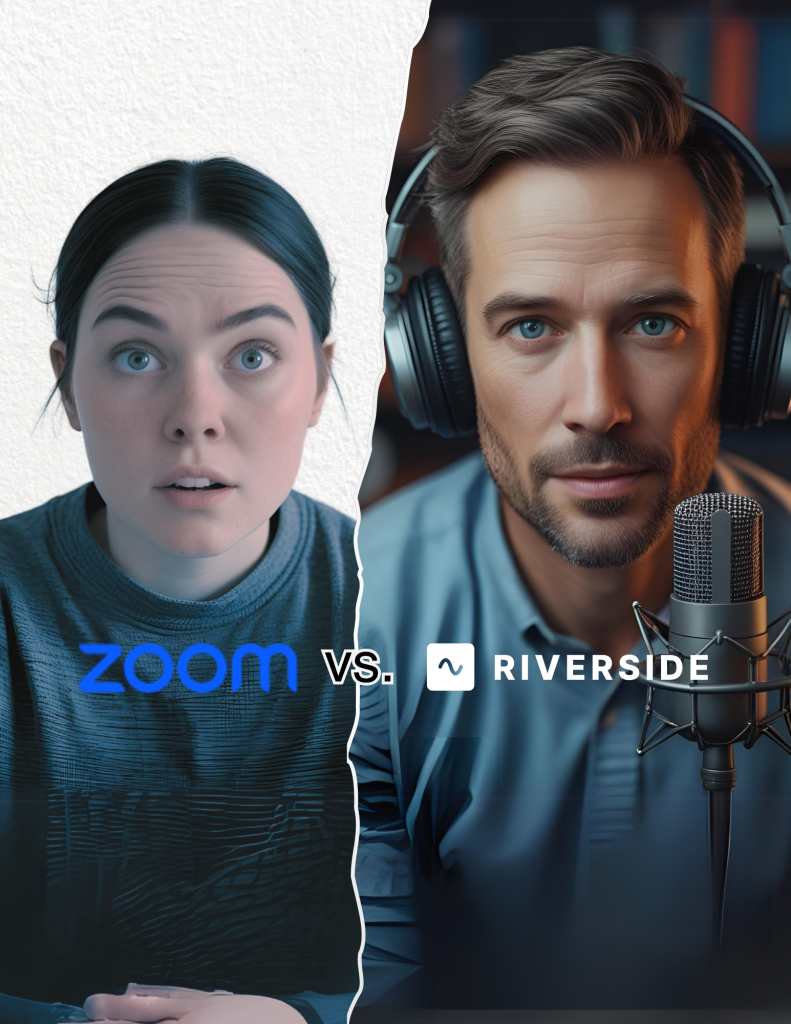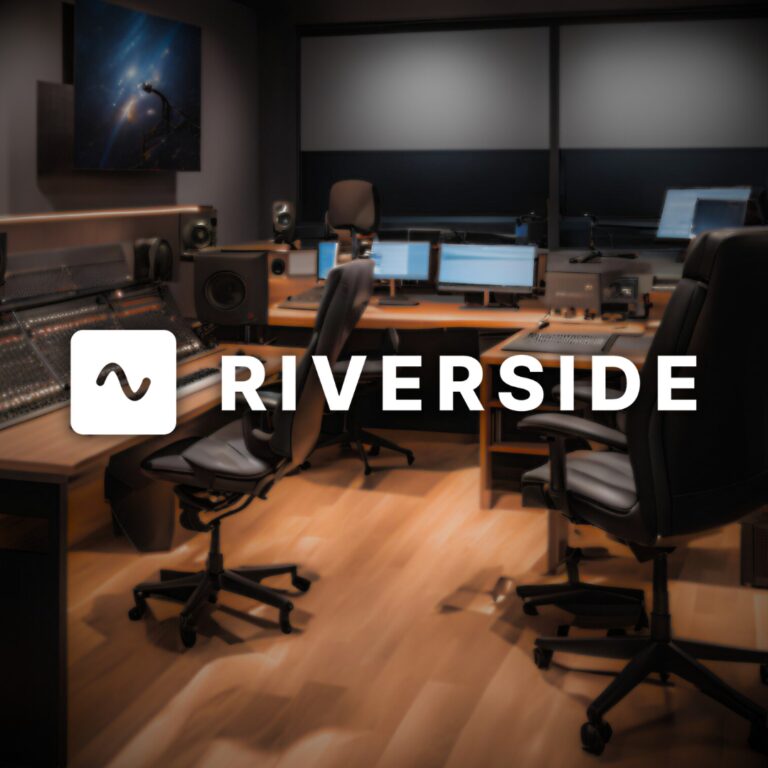When it comes to recording professional interviews, webinars, or podcasts, choosing the right platform makes all the difference. In this article, we’ll compare Riverside FM vs. Zoom to help content creators, podcasters, and business professionals understand which tool offers the best value for high-quality media production.
Zoom vs. Riverside FM Comparison
As content quality becomes more important for visibility, branding, and engagement, creators can no longer rely on software built for general meetings. This is why the Zoom vs. Riverside FM conversation is critical—using the wrong platform can compromise your video and audio quality, damage your reputation, or require hours of post-production work.
Platform Overview
Riverside FM
Riverside FM is a browser-based recording platform specifically designed for creators who require professional-grade output. It allows for high-resolution, local recordings, even if your internet lags. After recording, your content is automatically uploaded to the cloud. It also includes tools for branding, layout design, and post-production, making it ideal for podcasters, YouTubers, and content creators who rely on interviews.
Zoom
Zoom is a leader in video conferencing and remote team collaboration. It was built for meetings and webinars. While it’s great for business communication, its recordings are compressed and captured in real-time, meaning you only get what the internet allows during the call. This puts it at a disadvantage compared to Riverside FM in terms of content creation.
Zoom vs. Riverside FM Video and Audio Quality
Riverside FM
- Video: Up to 4K resolution (3840 x 2160)
- Audio: 48 kHz WAV files (uncompressed)
- Independent tracks for each participant
- Progressive local recording unaffected by internet interruptions
- Supports high-quality video from mobile and desktop devices
Zoom
- Video: Typically capped at 720p or 1080p (depending on plan)
- Audio: AAC format, compressed and lossy
- Single-track recordings unless manually configured
- Recording quality drops with a poor internet connection
In terms of professional audio and visual quality, Riverside FM vs. Zoom isn’t even close. Riverside FM is engineered for studio-grade output. Zoom is built for conversation, not content creation.
Color Accuracy and Video Consistency
One of the most overlooked differences in Riverside FM vs. Zoom for professional interviews is color accuracy. If you’ve ever recorded a Zoom interview and noticed your face looked too red, washed out, or overexposed, you’re not alone. Zoom often struggles with color grading and lighting balance, especially in varied lighting conditions or when using high-end cameras.
Zoom color distortion is a common issue reported by podcasters and content creators. Whether it’s unnatural skin tones, blown-out highlights, or strange saturation shifts, Zoom’s live-compression engine prioritizes speed over visual fidelity. The result: interview footage that appears amateur, even when using professional-level gear.
Riverside FM takes a different approach. Because it records video locally before compression, your footage maintains true-to-life color accuracy. Skin tones stay natural. Lighting looks clean and professional. This is crucial for maintaining consistency across platforms, including YouTube, Instagram, and your website, in post-production.
If you’re trying to build trust and authority through video interviews, poor color grading can make your brand look less polished. In the ongoing debate of Riverside FM vs. Zoom for professional interviews, color accuracy is one more reason Riverside is the tool serious creators rely on.
Recording Features Breakdown
Riverside FM
- Automatic progressive uploads during recording
- Multitrack audio and video (each guest and host on separate files)
- Magic Editor: edit layout, trim segments, auto-captions
- AI-generated transcriptions
- Media board: trigger sound effects, intros, and videos live
- Custom branding (logos, backgrounds, frames)
- Clips tool: extract short videos in 9:16, 1:1, or 16:9 aspect ratios
- Backstage mode: producers can monitor without being recorded
Zoom
- Manual local or cloud recording
- Limited editing capabilities post-recording
- Basic screen recording only (single track)
- Minimal layout customization
- Requires external software for branding or transcriptions
- Shared screen and speaker view recordings are often hard to edit
The winner of Zoom vs. Riverside FM, in terms of ease of use, quality, and editing capabilities, is clear. Riverside gives creators complete control of content presentation and repurposing.
Guest Experience
Riverside FM
- One-click browser access
- No software installation required (just Chrome or Edge)
- Mobile app for iOS/Android supports high-quality local recording
- Guests don’t need to create an account
- Simple UI with real-time preview of mic, camera, and quality levels
Zoom
- Requires app installation for full functionality
- Interface is designed for general users, not optimized for creators
- Guests may need to sign in or download updates
In Riverside FM vs. Zoom, ease of guest access and simplicity of recording go to Riverside. Especially when recording non-technical guests or celebrities.
Producer and Host Tools
Riverside FM
- Assign producer roles (not recorded, but can monitor and assist)
- Monitor upload quality, waveforms, and device connections in real-time
- Customize layout, branding, and guest presentation live
- Trigger overlays, videos, and sound clips during recording
Zoom
- The host can control mute/unmute, screen share, and basic layout
- No dedicated producer role
- Limited control over branding and live content management
When it comes to professional production environments, Riverside FM vs. Zoom favors Riverside for scalability and control.
Post-Production Workflow
Riverside FM
- Multitrack editing enables clean cuts and level adjustments
- Magic Editor with built-in layouts and auto-captions
- Download audio/video files immediately
- Export to Descript, Final Cut, Adobe Premiere, etc.
- Generate highlight clips with subtitles for Instagram Reels, TikTok, and Shorts
Zoom
- Requires external tools to clean up audio/video
- A single combined file is harder to edit
- The export process takes longer with large meetings or cloud delays
If you’re creating YouTube content, podcasts, or promotional clips, Riverside saves time and delivers better raw materials. This is the core reason many creators make the switch.
SEO, Branding, and Monetization Potential
When comparing Zoom vs. Riverside FM for SEO and branding impact:
- Riverside allows on-brand framing, custom backgrounds, and video intro/outro insertions
- High-quality video/audio increases viewer retention and shareability
- Separate tracks make it easy to create custom thumbnails and highlight quotes
- Zoom outputs generic footage that requires reformatting and quality enhancement
Riverside’s output supports better thumbnails, more compelling social media snippets, and highly searchable podcast content. This increases monetization potential through sponsorships, paid partnerships, and YouTube ads.
Pricing Comparison
Riverside FM
- Free plan with watermark
- Basic plan: $15/month – 2 hours/month recording
- Standard plan: $24/month – 5+ hours, multitrack, Magic Editor
- Pro plan: $29/month – advanced editor, live call-in, team roles
Zoom
- Free plan: 40-minute limit, basic features
- Pro: $15.99/month – 30-hour meetings, local recording
- Business: $19.99+/month – 300 participants, cloud recording
While costs are similar, the value for creators tilts heavily toward Riverside FM, which includes recording quality, editing tools, and production features without extra plugins or software.
Use Case Comparison Chart
| Use Case | Riverside FM | Zoom |
|---|---|---|
| Podcast Interviews | ✅ Studio-grade | ❌ Compressed |
| YouTube Video Production | ✅ 4K Ready | ❌ Low-res |
| Social Media Clip Creation | ✅ Built-in Clips | ❌ Manual Only |
| Guest Simplicity | ✅ No Install | ❌ App Required |
| Team Meetings | ❌ Basic Only | ✅ Fully Featured |
Riverside FM vs. Zoom Pros and Cons Recap
Riverside FM
- ✅ High-fidelity local recordings
- ✅ Separate video/audio tracks
- ✅ AI tools and a branded editor
- ❌ Browser-only on desktop
- ❌ Requires more technical setup
Zoom
- ✅ Reliable for live communication
- ✅ Simple for meetings and group calls
- ❌ Compressed output
- ❌ Not designed for editing or media use
Why I Switched from Zoom to Riverside FM
After using Zoom for interviews and struggling with file quality, sync issues, and the need for third-party editing tools, I made the switch to Riverside FM. My output immediately improved. I spent less time fixing problems in post and more time distributing content. Guests now enjoy a polished experience, and I consistently achieve professional results. If you’re serious about content, Riverside FM vs. Zoom isn’t a comparison—it’s a no-brainer.
Final Thoughts: Zoom vs. Riverside FM
If your priority is content quality, brand control, and time savings, Riverside FM is the better choice. Zoom remains the go-to platform for internal team meetings and live conversations, but for content intended for publication, Riverside delivers a higher production value, better flexibility, and faster workflows. Make the switch if you haven’t already done so. Your audience will notice the difference.



